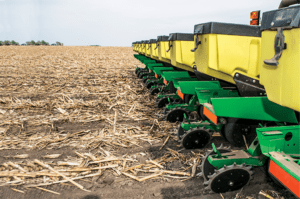-
Acres of No-Till Corn: 240 acres
-
Decrease in Fuel Usage (for Planting): 67%
-
Farmer Hours Saved: 120 hours
-
Tons of Carbon Sequestered: 72 metric tons
 In 2019, Barstow’s Longview Farm went 100% no-till.
In 2019, Barstow’s Longview Farm went 100% no-till.
We transitioned to no-till over the course of four years and moving away from tillage: a strategy this farm and many have used for generations. Tillage is the agricultural preparation of soil by mechanical agitation, typically removing weeds established in the previous season. Tilling can create a seed bed with formed areas (i.e. rows or raised beds) to enhance the growth of desired plants. It is an ancient technique with clear evidence of its use since at least 3000 B.C.
No-till planting is an agricultural technique for growing crops or pasture without disturbing the soil.
 Tilling the soil turns soil ecosystems on their head, annually, disrupting and killing the soil microbes and other organisms like mycorrhizae (a good soil fungus), arthropods (good soil bugs), and earthworm (everybody loves worms!). The loss of this organic matter contributes to degradation of the soil and releases tons of methane into the atmosphere.
Tilling the soil turns soil ecosystems on their head, annually, disrupting and killing the soil microbes and other organisms like mycorrhizae (a good soil fungus), arthropods (good soil bugs), and earthworm (everybody loves worms!). The loss of this organic matter contributes to degradation of the soil and releases tons of methane into the atmosphere.
Tillage makes the dirt on top fluffy and easy for planting, but that’s a big issue for erosion and soil run off. At the bottom of that tiller blade too, hidden from sight, is a layer of compacted soil which is no good for any soil habitat.
Tillage might make fields easier to drive on and plant in, but it’s generally not a good investment in soil health.
The transition to no-till planting often results in a yield drag. Farmers need to build their soils back up while still maintaining a steady crop for their animals and markets. However, once the soil recovers from tillage, yields with no-till farming are the same or better!
No-till planting has many benefits for the environment, the soil, and the farmer.

Benefits of No-Till Farming:
- decreases soil erosion
- increases water infiltration
- soil retention of organic matter
- increases the amount and variety of life in and on the soil
- increases carbon sequestration
- reduces soil compaction
- reduces fuel usage and machinery costs
- reduces labor costs
Carbon sequestration is the long-term removal, capture or isolation of carbon dioxide from the atmosphere to slow or reverse atmospheric CO2 pollution and to mitigate or reverse global warming. No-till is a practice that is climate forward and has a lot of support from government agencies like the USDA and NRCS (Natural Resource Conservation Services).
 The equipment required is a no-till planter which is towed behind the tractor. Each compartment holds seeds. The planter pushes blades into the soil, positioned to the depth for seed germination. The seed is dropped in and covered over as the machine continues forward. This minimizes soil disturbance and looks like a series of neat lines drawn in the dirt. Because the field is not plowed first, the farmer is often planting on top of dead cover crop from the previous season. The dead cover crop continues to hold the soil in place, but will not shade out the tiny seedlings as they begin to grow in the soil and sunlight.
The equipment required is a no-till planter which is towed behind the tractor. Each compartment holds seeds. The planter pushes blades into the soil, positioned to the depth for seed germination. The seed is dropped in and covered over as the machine continues forward. This minimizes soil disturbance and looks like a series of neat lines drawn in the dirt. Because the field is not plowed first, the farmer is often planting on top of dead cover crop from the previous season. The dead cover crop continues to hold the soil in place, but will not shade out the tiny seedlings as they begin to grow in the soil and sunlight.
Barstow’s Longview Farm uses a number of other best practices for soil health too.
No-till planting, using cover crops, rotational planting, manure management, and maintaining natural riparian zones along bodies of water ensure healthy soils and productive farmland for not just today, but for generations to come.
